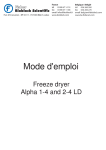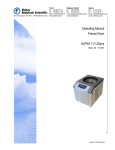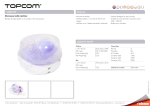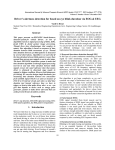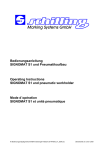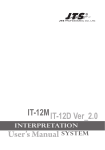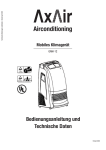Download Operating instructions
Transcript
Operating instructions Cleanox I, Cleanox II, Cleanox IV Electrochemical cleaning, polishing, marking and electroplating BEARCAT _ Telefono 937182060 _ www.bearcat.es 1 Table of contents 1. Foreword 2. EC and VDE Directives 3. Accident prevention 4. Safety instructions 5. Device description 6. Commissioning 6.1 Cable connection 6.2 Attachment of felts 6.3 Use of electrolytes and wide-neck containers 7. Cleaning 8. Polishing 9. Marking 9.1 Dark marking 9.2 Light marking 10. Cleaning containers, handles and workplace 11. Troubleshooting 12. Technical data 13. Maintenance 14. Material defects 15. Spare parts 16. Declaration of conformity REUTER GmbH & Co. KG – Hoffeldstr. 104 – 40235 D•sseldorf – Germany – www.oreuter.de 2 1. Foreword Thank you for purchasing this electrochemical cleaning device from REUTER GmbH & Co. KG. These operating instructions contain information on the safe use and operation of our electrochemical cleaning devices for cleaning, polishing, marking and electroplating. These instructions also contain information on basic concepts, applications, practical information and settings to avoid incorrect use. Your retailer will be happy to advise you on using the device, its applications and dealing with problems. Call our telephone hotline for advice on +49(0)171-5450200. Please read these operating instructions thoroughly before use. We hope this device will give you many years of good service. 2. EC and VDE Directives This cleaning device has the CE marking and complies with: EG Directive 89/336/EEC (EMC Directive) EC Directive 73/23/EEC (Low-voltage Directive) This cleaning device was manufactured in accordance with: EN 60742 (VDE 0551) EN 61558-1 (VDE 0570) 3. Accident prevention (accident prevention regulations) Hazards can be constituted by electrical current, harmful substances, gases. Read our safety data sheets for electrolytes and observe the hazard warnings. The following accident prevention regulations must be observed: VGB 1 General requirements VBG 4 Electrical installations and equipment VBG 100 Occupational safety and health VBG 109 First aid 4. Safety instructions - The cleaning device must only be used for the electrolytic cleaning processes described in these instructions. Use for any other purpose is not permitted. The cleaning device is intended for commercial use and must only be operated by trained and qualified persons. The cleaning device must only be used in ventilated locations. Vapours released in chemical reactions must not be inhaled; appropriate ventilation or extraction must be provided. Never place the cleaning electrode or handle on the workpiece or work surface so that the electrode or felt has contact with the metal surface since current will continue to flow and can cause damage or constitute a hazard. A short circuit or overheating will cause the built-in circuit-breaker to trip in order to protect the user and the device. REUTER GmbH & Co. KG – Hoffeldstr. 104 – 40235 D•sseldorf – Germany – www.oreuter.de 3 - 5. Wear suitable protective clothing while working; acid-resistant gloves, apron and safety goggles. If electrolyte should come into contact with the eyes, immediately rinse with plenty of water and seek the advice of an eye specialist. Do not eat or drink at the workplace, always wash hands thoroughly with soap and plenty of water after working with electrolytes. Observe the detailed information contained in our EC safety data sheet for electrolytes in any event. Electromagnetic fields can also influence pacemakers. Users of these devices must not work with the cleaning device. The cleaning device must be kept out of the reach of children. In order to avoid stray currents and their effects (e.g. damage to electrical protective conductors), the workpiece cable must be connected directly to the workpiece or support provided for the workpiece. Before each use, the power cable, mains plug, electrode cable, grounding cable handle and workpiece clamp must be inspected for external damage. In the event of accidents, the cleaning device must immediately be disconnected from the mains supply. Only qualified skilled persons may repair electrical components in the device or supply cables. Always disconnect the mains plug before carrying out maintenance. Always switch off the device before changing the carbon electrodes. Electrolyte can leave stains on stone floors or other surfaces. Device description/mode of operation CLEANOX and GALVANOX devices have been developed for commercial use in trade and industry and are suitable for electrochemical cleaning, polishing, marking and electroplating (only GALVANOX). These devices are used in particular for cleaning TIG welds on high-alloy steels and for marking all metallic surfaces. Tarnish and oxides on welds can be removed in an environmentally-friendly manner without the use of toxic mordants. This is made possible by an electrochemical process in which a specially dimensioned power source and precisely adjusted, highly diluted electrolytes activate redox processes in which the oxide layers are broken open and the damaging tarnish is quickly removed without any toxic fluoric or nitric acids, as otherwise used in usual conventional pickling processes. The devices operate with low DC and AC voltages which are not dangerous to humans. As a cleaning electrolyte we only use non-toxic mineral acids in different concentrations. Our electrolytes are also used in foods as acidulants and preservatives, e.g. in cola drinks, coffee whiteners or sliced white bread for toasting. It is also known as the food additive E338, albeit in low concentrations. The electrolytes are added in such small amounts that they do not produce any cleaning or marking effect on their own; chemical processes that produce the required effects are initially activated by electrolysis and temperature. Important in this respect is the precise adjustment of the electrolytes, voltage types, current levels and selection of the correct materials of the carbon electrodes and felts. Our many years of experience in the area of welding has enabled us to perfect this highly effective and environmentally-friendly cleaning process. 6. Commissioning The devices are designed for single-phase connection to 220V socket-outlets with earthing contact and fitted with a standard plug. Devices with special voltages are available as an option and supplied without plug. Prior to commissioning, refer to the data on the rating plate at the rear of the device. REUTER GmbH & Co. KG – Hoffeldstr. 104 – 40235 D•sseldorf – Germany – www.oreuter.de 4 6.1 Cable connection Note that the devices must be switched off before connecting cables and when changing the handles, carbon electrodes or felts (control switch set to AUS/OFF). There are two security power sockets on the front of the devices. Connect the red cable connector (with fixed insulating sleeve) to the red power socket and connect the connector (with transparent sliding insulating sleeve) to the red crocodile clip (workpiece ground). Follow the same procedure for the black cable and attach the connector to the electrode handle. Ensure that the grounding clip has adequate electrical contact at the workpiece and previously remove any rust, paint, scale or other impurities. 6.2 Attachment of felts The device should be switched off or the black connector removed from the handle before attaching or changing the felt. Two felt qualities are available as standard. The white felts are preferably used for marking and light cleaning of slightly tarnished TIG welds. The yellow felts are made from Kevlar€, the toughest fibres in the world and are preferably used for cleaning heavily tarnished TIG or MIG welds or for polishing. The felts must be attached to the carbon electrode; this prevents the current flowing in a short circuit between the carbon electrode and workpiece and allows the current to flow indirectly through the electrolyte saturated felt, which protects the material. Fold the felt in half, place it over the carbon electrode and fix it in place with the O-ring. The felts must be renewed in good time before the material strength is reduced by wear and current flashovers are caused in a short circuit. These is no risk to the user or devices as a circuit breaker in the device trips on overcurrent. Short circuits may cause damage to workpiece surfaces if felts are damaged or have holes. The felts must therefore always be kept moist by repeatedly dipping the electrode handles in the electrolyte container. This cools the felts and carbon electrode and extends the service life. Attention: The temperature on the carbon electrode can be as high as 200•C during extended use, in particular when polishing! Never use the same felt for cleaning or marking as this can cause electrolyte entrainment and undesired reactions and discolouration on the workpiece surface. For marking purposes, it is recommended to use an additional marking handle with a 90• carbon electrode in order to avoid undesired blackening through marking electrolyte when cleaning or polishing. 6.3 Using electrolyte and wide-neck containers We supply cleaning and polishing electrolytes in various container sizes: 0.5kg, 1kg, 6x1kg or 5 kg. The containers are never filled to the top for production reasons and the filling level depends on the specific electrolyte density. POLISHER is more highly concentrated and has almost double the density than CLEANER electrolyte. This explains the different filling levels in containers with the same weight. Our containers are provided with safety closures and are therefore sealed leak-proof until opened. Unscrew the screw cap and carefully pierce two holes through the aluminium seals. Pour electrolyte into the wideneck container so that it almost covers the carbon electrode or felt or fill to the first lower mark on the wide-neck container. Never overfill the wide-neck container to avoid the handle becoming wet and electrolyte coming into contact with the hands. REUTER GmbH & Co. KG – Hoffeldstr. 104 – 40235 D•sseldorf – Germany – www.oreuter.de 5 The wide-neck container can also be used as an electrically insulated means of storage for the handle and for cooling the electrode during breaks. Attention: Read the detailed safety information in our safety data sheets in any event! 7. Cleaning Two different electrolytes are available for cleaning stainless steel welds; CLEANER for TIG welds with light to normal tarnish and SUPERCLEANER for MIG welds or heavily oxidised surfaces with local scaling. Tip: Never use excessive energy for welding. The better the welding quality, the faster the cleaning process! Fill the CLEANER electrolyte to the lower mark in the wide-neck container, about 2 cm high. Attach a felt to the carbon electrode of the cleaning handle, see 6.2. For cleaning lightly tarnished welds, the white cleaning/marking felts can be used. For cleaning heavily tarnished or rough welds, the yellow Kevlar€ felts can be used. Attach the black cable connector to the electrode handle and turn the switch on the device to Reinigen/Cleaning. Attach the red cable with the crocodile clip to the workpiece. Dip the handle in the wide-neck container so that the felt is fully saturated with electrolyte and allow the excess to drip off while removing it from the container. Exerting only light pressure, move the cleaning handle along the weld. Exerting more pressure will increase the wear on the felts and not improve the result. Depending on the action of heat during the welding process, movement along the weld may have to be repeated in order to remove the oxides completely. Move the handle similar to painting with a brush. The darker the tarnish on the welds, the longer the cleaning phase. Scaling as a result of excessive temperature during welding or due to a lack of gas, etc., cannot be removed completely as these oxides are no longer metallic, i.e. no longer electrically conductive. The cleaning effect for heavily oxidised welds can be slightly improved using SUPERCLEANER and yellow Kevlar felts. Otherwise, the only other option is mechanical removal by brushing or grinding. Regularly dip the electrode in the wide-neck container in order to remove the dislodged oxides from the contaminated felt and to pick up fresh electrolyte. Attention: Cleaning for prolonged periods without wetting the felt will give rise to increased felt wear, expose the electrode and workpiece to higher temperatures and reduce the cleaning effect! Excessive felt wear can result in direct contact of the carbon electrode with the workpiece and lead to short circuits or light arcing which can cause unsightly marks on the workpiece. Tip: Tip: Move the handle with the electrode tip back and forth along the weld, slightly changing the angle at the same time. This will help achieve the best cleaning result. Matt areas to the right and left of the weld after cleaning are normal and cannot be removed by more intensive cleaning! The matt areas in the heat-affected zone result from chromium depletion which is due to the welding process. The gloss level can be increased by polishing the matt areas! Never clean one area for too long, remove electrolyte residues and dislodged oxides with plenty of water. Every device includes a spray bottle for this purpose. The water hardness must be below 10 or distilled water should be used in order to avoid unsightly white limescale. Clean the surface with paper towels and dry; if necessary finish the workpiece with a commercially available stainless steel cleaner in order to make the surface insensitive to renewed contamination such as finger prints. REUTER GmbH & Co. KG – Hoffeldstr. 104 – 40235 D•sseldorf – Germany – www.oreuter.de 6 8. Polishing For polishing stainless steel surfaces or welds, use POLISHER electrolyte and only the yellow Kevlar cleaning/polishing felts. Previously cleaned welds can be brightly polished or the gloss level adjusted to the surrounding surface as required. Oxides and scale which could not be removed completely during the cleaning process can be almost removed by polishing. However, this produces a slightly bright surface. Proceed as described in Chapter 7. Cleaning; fill POLISHER electrolyte in the wide-neck container and attach the yellow polishing felt to the cleaning or polishing handle. Set the control switch on the device to the setting Polieren/Polishing. Slowly move the handle along the workpiece exerting only light pressure using a circular movement. Regularly dip the electrode in the wide-neck container to pick up fresh electrolyte and cool the electrode. High temperatures occur while polishing so that the workpiece and electrode must be cooled with plenty of electrolyte. It is therefore essential to dip the handle in the wide-neck container at regular intervals and to leave it in the container for a short time if necessary. Attention: Temperatures on the carbon electrode and workpiece can reach 200•C while polishing. Avoid burns through direct contact with the electrode and surfaces that have just been cleaned, rinse with plenty of water after polishing. Keep a distance from the area being polished to avoid directly inhaling the vapours. Ensure good ventilation or extraction! Tip: For polishing use our white Teflon polishing handle, which is extremely resistant to the highly concentrated POLISHER electrolyte and resistant to temperatures above 250•C. The unique design of the handle offers insulation against the high temperatures prevailing on the electrode and ensures comfortable and fatigueless use. Do not polish one area for too long to avoid high workpiece temperatures and thermal distortion. Regularly dip the electrode in the wide-neck container with new electrolyte and allow the electrode to cool down slightly in the container. Rinse the workpiece surface with water from time to time. The spray bottle supplied with the device can be used for this purpose. Avoid using water that is too hard or use distilled water if necessary to prevent limescale marks on the freshly polished surface. Rinse with water until the workpiece surface has cooled down completely and subsequently wipe dry with paper towels. 9. Marking 9.1 Dark marking All electrically conductive metal surfaces can be marked with the appropriate electrolyte. Dark marking is a desired oxidation process on the metal surface and not the application of colour particles. It is therefore permanent and forgery-proof! Attach a white marking felt to the carbon electrode of the marking handle and pour a few drops of the marking electrolyte on to the felt until it is completely saturated. Set the control switch to the dark marking position. Place the long-term template or marking tape on the workpiece. Tip: The templates will adhere to the workpiece more easily and are less likely to move when moistened with water! REUTER GmbH & Co. KG – Hoffeldstr. 104 – 40235 D•sseldorf – Germany – www.oreuter.de 7 Slowly move the handle over the template exerting only light pressure. The marking time should be maximum between 1 and 3 seconds to avoid loading the templates unnecessarily. Do not move the handle beyond the edge of the template to avoid darkening the workpiece surface next to the template. Tip: The degree of blackening depends on the marking duration, electrolyte used and the material. Remove the template from the workpiece, thoroughly remove the electrolyte residues with water and dry the surface with a paper towel. Neutralyte (see catalogue) can also be used to remove electrolyte residues and prevent subsequent rusting of surfaces sensitive to corrosion. Attention: Clean the handles and carbon electrodes thoroughly and do not use the same felts for marking and cleaning as this can cause undesired surface discolouration when cleaning through electrolyte entrainment. 9.2 Light marking For light marking, material on the workpiece surface is removed and a recess similar to an engraving is produced. This is also known as etching. Light marking is preferably used for aluminium as this material is not suitable for dark marking. Proceed as described under 9.1, however set the switch to light marking. Attention: Insufficient electrolyte or an excessive exposure time can burn or damage the foil. Work should initially be carried out in short cycles and the marking evaluated until the required result is achieved. 10. Cleaning containers, handles and workplace After cleaning or marking, implements and the workplace must be cleaned thoroughly with water to avoid damage to the surfaces through electrolyte residues. Thoroughly clean the electrode handles and carbon under running water and remove and dispose of the felts. Using a cloth, wipe the cables and crocodile clip with water. Fill the wide-neck container with the contaminated electrolyte with water and dispose of the effluent; subsequently rinse the container inside and out with water. Remove electrolyte residues around the workplace, in particular on the workbench and floor with plenty of water and a commercially available detergent or soap. Attention: 11. Do not discharge contaminated electrolyte undiluted to the sewerage system or environment. The contaminated electrolyte can contain heavy metal residues dislodged from oxidised welds and metal surfaces, which must be filtered and disposed of in a proper manner. Dilute the electrolyte with plenty of water, lime or neutralyte until the pH is above 5. Troubleshooting REUTER GmbH & Co. KG – Hoffeldstr. 104 – 40235 D•sseldorf – Germany – www.oreuter.de 8 Problem No cleaning action - Weld or surface is matt Felts burn and electrode becomes hot Polished workpiece surface becomes matt again Felts wear too quickly Marking does not function - Stains after cleaning, polishing, rinsing - 12. Remedy Device not switched on Crocodile clip not connected Workpiece/electrolyte temperature too low Excessive use on one area Surface too hot Insufficient electrolyte Electrolyte quality poor or spent Insufficient electrolyte used Regularly dip the electrode in the wide-neck container and cool Surface temperature too high Do not polish for too long on one area Use more electrolyte more regularly Cool with water from time to time Welds too rough Sharp edges Kevlar felts not used for polishing Too much pressure exerted while working Insufficient electrolyte used No electrolyte between template and workpiece Incorrect electrolyte for aluminium, possibly anodised surface Incorrect electrolyte Insufficient rinsing with water Limescale residues due to high water hardness Surface too hot through prolonged polishing Electrolyte residues Electrolyte entrainment through marking residues or electrolyte Technical data Operating voltage Power Electrode voltage Weight Dimensions DxWxH mm Degree of protection 230V – 50Hz 400 VA 0 – 35 V 10 kg 275 x 140 x 200 IP23 REUTER GmbH & Co. KG – Hoffeldstr. 104 – 40235 D•sseldorf – Germany – www.oreuter.de 9 13. Maintenance Maintenance of the cleaning device consists of thorough cleaning and inspection by a skilled person. The frequency depends on the degree of soiling. Before carrying out any work, the device must be disconnected from the mains supply (disconnect the mains plug). Dust deposits must be removed with a vacuum cleaner. Wipe components with a dry cloth. Only use degreasing agents suitable for electrical equipment. Ensure that repeat tests are carried out according to VBG 4 as prescribed by the Institution for Statutory Accident Insurance and Prevention. 14. Material defects The customer must immediately notify the supplier of any material defects within 14 days in writing. If no limitation period for claims is agreed between the supplier and customer, the legal regulations apply. In the event of a claim relating to a material defect, a certificate must be presented showing that the period of limitation has not been exceeded. 15. Spare and wearing parts Spare and wearing parts can be found in our main catalogue as well as all consumables. Example catalogue page: REUTER GmbH & Co. KG – Hoffeldstr. 104 – 40235 D•sseldorf – Germany – www.oreuter.de 10 EC declaration of conformity Device designation: Device for electrochemical cleaning, marking, polishing and electroplating of metals. The device complies in its design and type of construction with the type marketed by us in compliance with the requirements of the following directives: - EC – Low-voltage Directive 73/23/EWG Reference standards: - EN 60742 (VDE 0551) - EN 61558-1 (VDE 0570) This declaration will be rendered null and void in the event of unauthorised modifications, improper repairs or conversions that are not expressly authorised by the manufacturer. Dƒsseldorf, 10.09.2010 Company stamp/Signature REUTER GmbH & Co. KG – Hoffeldstr. 104 – 40235 D•sseldorf – Germany – www.oreuter.de 11















